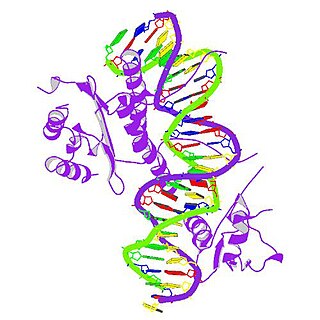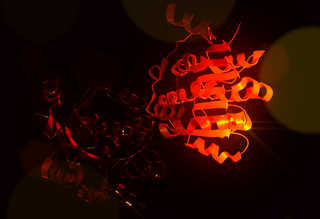Nascent-polypeptide-associated complex alpha polypeptide, also known as NACA, is a protein which in humans is encoded by the NACA gene. [5] [6] [7]
Nascent-polypeptide-associated complex alpha polypeptide, also known as NACA, is a protein which in humans is encoded by the NACA gene. [5] [6] [7]
NACA prevents short recently synthesized (i.e., nascent) ribosome-associated polypeptides from inappropriate interactions with cytosolic proteins. NACA binds nascent-polypeptide domains emerging from ribosomes unless it contains a signal peptide which is fully exposed. Depletion of NACA from ribosomes carrying nascent polypeptides allows the signal recognition particle (SRP) to crosslink to polypeptides regardless of whether or not they contain signal peptides or not. In the absence of NACA, proteins lacking signal peptides can be mis-translocated into the endoplasmic reticulum. [6] [8]
The NACA protein is expressed in bone during development and acts as a transcriptional coactivator in conjunction with acidic activators. [7]
NACA has been shown to interact with BTF3, FADD, [9] C-jun, [10] and 3 members of taxilin family. [11]

Histone acetyltransferase p300 also known as p300 HAT or E1A-associated protein p300 also known as EP300 or p300 is an enzyme that, in humans, is encoded by the EP300 gene. It functions as histone acetyltransferase that regulates transcription of genes via chromatin remodeling by allowing histone proteins to wrap DNA less tightly. This enzyme plays an essential role in regulating cell growth and division, prompting cells to mature and assume specialized functions (differentiate), and preventing the growth of cancerous tumors. The p300 protein appears to be critical for normal development before and after birth.

The nuclear receptor coactivator 3 also known as NCOA3 is a protein that, in humans, is encoded by the NCOA3 gene. NCOA3 is also frequently called 'amplified in breast 1' (AIB1), steroid receptor coactivator-3 (SRC-3), or thyroid hormone receptor activator molecule 1 (TRAM-1).

Retinoid X receptor alpha (RXR-alpha), also known as NR2B1 is a nuclear receptor that in humans is encoded by the RXRA gene.

Serum response factor, also known as SRF, is a transcription factor protein.

Probable ATP-dependent RNA helicase DDX5 also known as DEAD box protein 5 or RNA helicase p68 is an enzyme that in humans is encoded by the DDX5 gene.

Cyclin-C is a protein that in humans is encoded by the CCNC gene.

Transcription initiation factor TFIID subunit 2 is a protein that in humans is encoded by the TAF2 gene.

Mediator of RNA polymerase II transcription subunit 14 is an enzyme that in humans is encoded by the MED14 gene.

Tripartite motif-containing 24 (TRIM24) also known as transcriptional intermediary factor 1α (TIF1α) is a protein that, in humans, is encoded by the TRIM24 gene.

Peroxisome proliferator-activated receptor gamma coactivator 1-beta is a protein that in humans is encoded by the PPARGC1B gene.

Mediator of RNA polymerase II transcription subunit 6 is one of the subunits of the Mediator complex. It is an enzyme that in humans is encoded by the MED6 gene.

Polypeptide N-acetylgalactosaminyltransferase 3 is an enzyme that in humans is encoded by the GALNT3 gene.

Polypeptide N-acetylgalactosaminyltransferase 1 is an enzyme that in humans is encoded by the GALNT1 gene.

N-alpha-acetyltransferase 15, NatA auxiliary subunit also known as gastric cancer antigen Ga19 (GA19), NMDA receptor-regulated protein 1 (NARG1), and Tbdn100 is a protein that in humans is encoded by the NAA15 gene. NARG1 is the auxiliary subunit of the NatA complex. This NatA complex can associate with the ribosome and catalyzes the transfer of an acetyl group to the Nα-terminal amino group of proteins as they emerge from the exit tunnel.

Mediator of RNA polymerase II transcription subunit 17 is an enzyme that in humans is encoded by the MED17 gene.

TAF6-like RNA polymerase II p300/CBP-associated factor-associated factor 65 kDa subunit 6L is an enzyme that in humans is encoded by the TAF6L gene.

Prefoldin subunit 2 is a protein that in humans is encoded by the PFDN2 gene.

Mediator of RNA polymerase II transcription subunit 16 is an enzyme that in humans is encoded by the MED16 gene.

Polypeptide N-acetylgalactosaminyltransferase 6 is an enzyme that in humans is encoded by the GALNT6 gene.

Transcription initiation factor TFIID subunit 9B is a protein that in humans is encoded by the TAF9B gene.